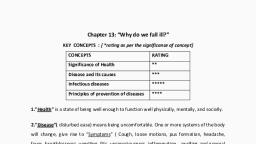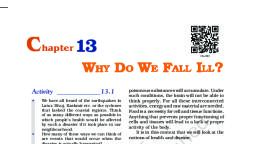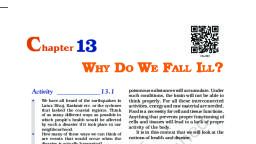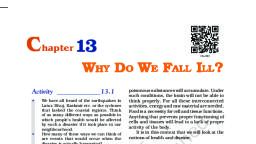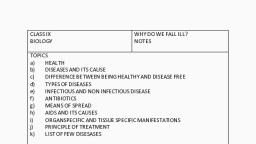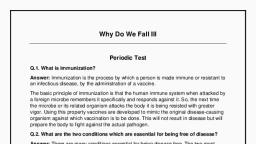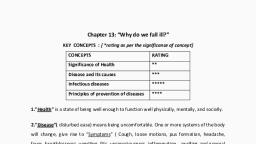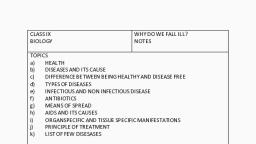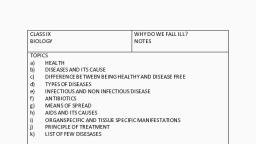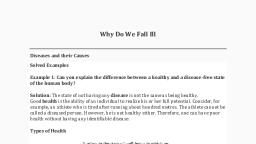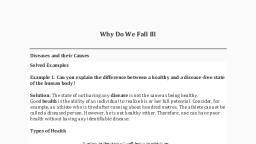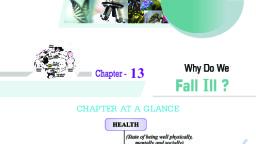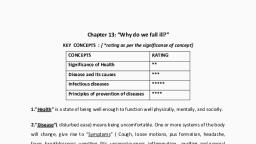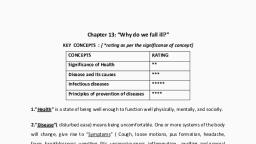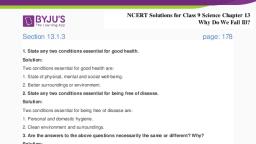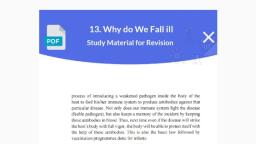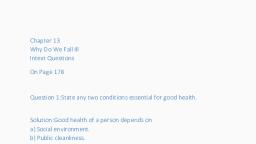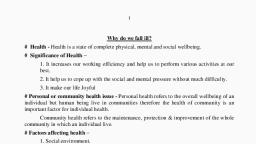Page 1 :
Chapter 13, WHY DO WE FALL ILL?, Activity _____________ 13.1, •, , •, , •, , •, , We have all heard of the earthquakes in, Latur, Bhuj, Kashmir etc. or the cyclones, that lashed the coastal regions. Think, of as many different ways as possible in, which people’s health would be affected, by such a disaster if it took place in our, neighbourhood., How many of these ways we can think of, are events that would occur when the, disaster is actually happening?, How many of these health-related events, would happen long after the actual, disaster, but would still be because of the, disaster?, Why would one effect on health fall into, the first group, and why would another, fall into the second group?, , When we do this exercise, we realise that, health and disease in human communities, are very complex issues, with many, interconnected causes. We also realise that, the ideas of what ‘health’ and ‘disease’ mean, are themselves very complicated. When we, ask what causes diseases and how we prevent, them, we have to begin by asking what these, notions mean., We have seen that cells are the basic units, of organisms. Cells are made of a variety of, chemical substances–proteins, carbo-hydrates,, fats or lipids, and so on. Cell is a dynamic place., Something or the other is always happening, inside them. Complex reactions and repair goes, on inside cells. New cells are being made. In, our organs or tissues, there are various, specialised activities going on– the heart is, beating, the lungs are breathing, the kidney, is filtering urine, the brain is thinking., All these activities are interconnected. For, example, if the kidneys are not filtering urine,, , poisonous substances will accumulate. Under, such conditions, the brain will not be able to, think properly. For all these interconnected, activities, energy and raw material are needed., Food is a necessity for cell and tissue functions., Anything that prevents proper functioning of, cells and tissues will lead to a lack of proper, activity of the body., It is in this context that we will look at the, notions of health and disease., , 13.1 Health and its Failure, 13.1.1 THE, , SIGNIFICANCE OF ‘HEALTH’, , We have heard the word ‘health’ used quite, frequently. We use it ourselves as well, when, we say things like ‘my grandmother’s health, is not good’. Our teachers use it when they, scold us saying ‘this is not a healthy attitude’., What does the word ‘health’ mean?, If we think about it, we realise that it, always implies the idea of ‘being well’. We can, think of this well-being as ef fective, functioning. For our grandmothers, being able, to go out to the market or to visit neighbours, is ‘being well’, and not being able to do such, things is ‘poor health’. Being interested in, following the teaching in the classroom so that, we can understand the world is called a, ‘healthy attitude’; while not being interested, is called the opposite. ‘Health’ is therefore a, state of being well enough to function well, physically, mentally and socially., , 13.1.2 PERSONAL AND COMMUNITY ISSUES, BOTH MATTER FOR HEALTH, , If health means a state of physical, mental and, social well-being, it cannot be something that, , 2021-22
Page 2 :
each one of us can achieve entirely on our own., The health of all organisms will depend on, their surroundings or their environment. The, environment includes the physical, environment. So, for example, health is at risk, in a cyclone in many ways., Human beings live in societies. Our social, environment, therefore, is an important factor, in our individual health. We live in villages,, towns or cities. In such places, even our, physical environment is decided by our social, environment., Consider what would happen if no agency, is ensuring that garbage is collected and, disposed. What would happen if no one takes, responsibility for clearing the drains and, ensuring that water does not collect in the, streets or open spaces?, So, if there is a great deal of garbage, thrown in our streets, or if there is open drainwater lying stagnant around where we live,, the possibility of poor health increases., Therefore, public cleanliness is important for, individual health., , Activity _____________ 13.2, •, , •, , Find out what provisions are made by, your local authority (panchayat/, municipal corporation) for the supply, of clean drinking water., Are all the people in your locality able, to access this?, , Activity _____________ 13.3, •, , •, •, •, , Find out how your local authority, manages the solid waste generated in, your neighbourhood., Are these measures adequate?, If not, what improvements would you, suggest?, What could your family do to reduce, the amount of solid waste generated, during a day/week?, , We need food to be healthy, and this food, will have to be earned by doing work. For this,, the opportunity to do work has to be available., We need to be happy in order to be truly, healthy, and if we mistreat each other and are, afraid of each other, we cannot be happy or, , healthy. Social equality and harmony are, therefore necessary for individual health. We, can think of many other such examples of, connections between community issues and, individual health., The Five ‘F’s — What is to be done?, Protect the water source (H), Treat and store water, safely (S), Wash hands before preparing and, taking food (H), Wash hands after defecation (S), , Cover the food (H), Control flies (S), Faecal matter, , Healthy person, , Clean vegetables and fruits before, use (H), Avoid open defecation (S), , Proper drainage system (H), Treatment of water (S), , Hygiene, Sanitation, , Prevention of Transmission of Diseases by Maintaining, Sanitation and Hygiene, , 13.1.3 DISTINCTIONS BETWEEN ‘HEALTHY’, AND ‘DISEASE-FREE’, If this is what we mean by ‘health’, what do we, mean by ‘disease’? The word is actually selfexplanatory – we can think of it as ‘disease’ –, disturbed ease. Disease, in other words,, literally means being uncomfortable. However,, the word is used in a more limited meaning., We talk of disease when we can find a specific, and particular cause for discomfort. This does, not mean that we have to know the absolute, final cause; we can say that someone is, suffering from diarrhoea without knowing, exactly what has caused the loose motions., We can now easily see that it is possible to, be in poor health without actually suffering, from a particular disease. Simply not being, diseased is not the same as being healthy., ‘Good health’ for a dancer may mean being, able to stretch his body into difficult but, graceful positions. On the other hand, good, health for a musician may mean having enough, breathing capacity in his/her lungs to control, the notes from his/her flute. To have the, opportunity to realise the unique potential in, all of us is also necessary for real health., 177, , WHY DO WE FALL ILL?, , 2021-22
Page 3 :
So, we can be in poor health without there, being a simple cause in the form of an, identifiable disease. This is the reason why,, when we think about health, we think about, societies and communities. On the other, hand, when we think about disease, we think, about individual sufferers., , Q, , uestions, 1. State any two conditions essential, for good health., 2. State any two conditions essential, for being free of disease., 3. Are the answers to the above, questions necessarily the same or, different? Why?, , 13.2 Disease and Its Causes, 13.2.1 WHAT DOES DISEASE LOOK LIKE?, Let us now think a little more about, diseases. In the first place, how do we know, that there is a disease? In other words, how, do we know that there is something wrong, with the body? There are many tissues in, the body, as we have seen in Chapter 6., These tissues make up physiological, systems or organ systems that carry out, body functions. Each of the organ systems, has specific organs as its parts, and it has, particular functions. So, the digestive, system has the stomach and intestines, and, it helps to digest food taken in from outside, the body. The musculoskeletal system,, which is made up of bones and muscles,, holds the body parts together and helps the, body move., When there is a disease, either the, functioning of one or more systems of the body, will change for the worse. These changes give, rise to symptoms and signs of disease., Symptoms of disease are the things we feel as, being ‘wrong’. So we have a headache, we have, cough, we have loose motions, we have a, wound with pus; these are all symptoms., These indicate that there may be a disease, but, they don’t indicate what the disease is. For, example, a headache may mean just, , examination stress or, very rarely, it may, mean meningitis, or any one of a dozen, different diseases., Signs of disease are what physicians will, look for on the basis of the symptoms. Signs, will give a little more definite indication of the, presence of a particular disease. Physicians will, also get laboratory tests done to pinpoint the, disease further., , 13.2.2 ACUTE AND CHRONIC DISEASES, The manifestations of disease will be different, depending on a number of factors. Some, diseases last for only very short periods of time,, and these are called acute diseases. We all know, from experience that the common cold lasts, only a few days. Other ailments can last for a, long time, even as much as a lifetime, and are, called chronic diseases. An example is the, infection causing elephantiasis, which is very, common in some parts of India., , Activity _____________ 13.4, •, , •, •, •, , Survey your neighbourhood to find out:, (1) how many people suffered from, acute diseases during the last, three months,, (2) how many people developed, chronic diseases during this same, period,, (3) and finally, the total number of, people suffering from chronic, diseases in your neighbourhood., Are the answers to questions (1) and, (2) different?, Are the answers to questions (2) and, (3) different?, What do you think could be the, reason for these differences? What do, you think would be the effect of these, differences on the general health of, the population?, , 13.2.3 C HRONIC, , DISEASES AND POOR, , HEALTH, , Acute and chronic diseases have different, effects on our health. Any disease that causes, poor functioning of some part of the body will, affect our health. This is because all functions, of the body are necessary for being healthy., , 178, , SCIENCE, , 2021-22
Page 4 :
But an acute disease, which is over very soon,, will not have time to cause major effects on, general health, while a chronic disease will do, so., As an example, think about a cough and, cold, which all of us have from time to time., Most of us get better and become well within a, week or so. And there are no lasting effects on, our health. But if we get infected with a chronic, disease such as tuberculosis of the lungs, then, being ill over the years does make us lose, weight and feel tired all the time., We may not go to school for a few days if, we have an acute disease. But a chronic, disease will make it difficult for us to follow, what is being taught in school and reduce our, ability to learn. In other words, we are likely, to have prolonged general poor health if we, have a chronic disease. Chronic diseases, therefore, have very drastic long-term effects, on people’s health as compared to acute, diseases., , 13.2.4 CAUSES OF DISEASES, What causes disease? When we think about, causes of diseases, we must remember that, there are many levels of such causes. Let us, look at an example. If there is a baby suffering, from loose motions, we can say that the cause, of the loose motions is probably an infection., But the next question is – where did the, infection come from? Suppose we find that the, infection came through unclean drinking, water. But many babies must have had this, unclean drinking water. So, why is it that one, baby developed loose motions when the other, babies did not?, One reason might be that this baby is not, healthy. As a result, it might be more likely to, have disease when exposed to risk, whereas, healthier babies would not. Why is the baby, not healthy? Perhaps because it is not well, nourished and does not get enough food. So,, lack of good nourishment becomes a second, cause of the disease. Further, why is the baby, not well nourished? Perhaps because it is from, a household which is poor., It is also possible that the baby has some, genetic difference that makes it more likely to, suffer from loose motions when exposed to a, pathogen. Without the pathogen, the genetic, , difference or the poor nourishment alone, would not lead to loose motions. But they do, become contributory causes of the disease., Why was there no clean drinking water for, the baby? Perhaps because the public services, are poor where the baby’s family lives. So,, poverty or lack of public services become third, cause of the baby’s disease., It will now be obvious that all diseases will, have immediate causes and contributory, causes. Also, most diseases will have many, causes, rather than one single cause., , 13.2.5 INFECTIOUS AND NON-INFECTIOUS, CAUSES, , As we have seen, it is important to keep public, health and community health factors in mind, when we think about causes of diseases. We, can take that approach a little further. It is, useful to think of the immediate causes of, disease as belonging to two distinct types. One, group of causes is the infectious agents,, mostly micr obes or micro-organisms., Diseases where microbes are the immediate, causes are called infectious diseases. This is, because the microbes can spread in the, community, and the diseases they cause will, spread with them., Things to ponder, 1. Do all diseases spread to people, coming in contact with a sick person?, 2. What are the diseases that are not, spreading?, 3. How would a person develop those, diseases that don’t spread by contact, with a sick person?, On the other hand, there are also diseases, that are not caused by infectious agents. Their, causes vary, but they are not external causes, like microbes that can spread in the, community. Instead, these are mostly internal,, non-infectious causes., For example, some cancers are caused by, genetic abnormalities. High blood pressure, can be caused by excessive weight and lack, of exercise. You can think of many other, diseases where the immediate causes will not, be infectious., 179, , WHY DO WE FALL ILL?, , 2021-22
Page 5 :
Peptic ulcers and the Nobel prize, For many years, everybody used to think, that peptic ulcers, which cause acidity–, related pain and bleeding in the stomach, and duodenum, were because of lifestyle, reasons. Everybody thought that a stressful, life led to a lot of acid secretion in the, stomach, and eventually caused peptic, ulcers., Then two Australians made a discovery, that a bacterium, Helicobacter pylori, was, responsible for peptic ulcers. Robin Warren, (born 1937), a pathologist from Perth,, Australia, saw these small curved bacteria, in the lower part of the stomach in many, patients. He noticed that signs of, inflammation were always present around, these bacteria. Barry Marshall (born 1951),, a young clinical fellow, became interested, in Warren’s findings and succeeded in, cultivating the bacteria from these sources., In treatment studies, Marshall and, Warren showed that patients could be cured, of peptic ulcer only when the bacteria were, killed off from the stomach. Thanks to this, pioneering discovery by Marshall and, Warren, peptic ulcer disease is no longer a, chronic, frequently disabling condition, but, a disease that can be cured by a short, period of treatment with antibiotics., For this achievement, Marshall and, , Warren (seen in the picture) received the, Nobel prize for physiology and medicine in, 2005., , The ways in which diseases spread, and, the ways in which they can be treated and, prevented at the community level would be, different for different diseases. This would, depend a lot on whether the immediate causes, are infectious or non-infectious., , Q, , uestions, 1. List any three reasons why you, would think that you are sick and, ought to see a doctor. If only one, of these symptoms were present,, would you still go to the doctor?, Why or why not?, 2. In which of the following case do, you think the long-term effects on, your health are likely to be most, unpleasant?, • if you get jaundice,, • if you get lice,, • if you get acne., Why?, , 13.3 Infectious Diseases, 13.3.1 INFECTIOUS AGENTS, We have seen that the entire diversity seen in, the living world can be classified into a few, groups. This classification is based on, common characteristics between different, organisms. Organisms that can cause disease, are found in a wide range of such categories, of classification. Some of them are viruses,, some are bacteria, some are fungi, some are, single-celled animals or protozoans (Fig. 13.1)., Some diseases are also caused by, multicellular organisms, such as worms of, different kinds., , 180, , SCIENCE, , 2021-22
Page 6 :
Fig. 13.1(a): Picture of SARS viruses coming out (see, arrows for examples) of the surface of, an infected cell. The white scale line, represents 500 nanometres, which is, half a micrometre, which is onethousandth of a millimetre. The scale line, gives us an idea of how small the things, we are looking at are., Courtesy:, Emerging Infectious, Deseases, a journal of CDC, U.S., , Fig. 13.1(d): Picture of Leishmania, the protozoan, organism that causes kala-azar. The, organisms are oval-shaped, and each, has one long whip-like structure. One, organism (arrow) is dividing, while a cell, of the immune system (lower right) has, gripped on the two whips of the dividing, organism and is sending cell processes, up to eat up the organism. The immune, cell is about ten micrometres in diameter., , Fig. 13.1(b): Picture of staphylococci, the bacteria, which can cause acne. The scale of the, image is indicated by the line at top left,, which is 5 micrometres long., , Fig. 13.1(c): Picture of Trypanosoma, the protozoan, organism responsible for sleeping, sickness. The organism is lying next to, a saucer-shaped red blood cell to give, an idea of the scale., Copyright: Oregon Health and Science, University, U.S., , Fig. 13.1(e): Picture of an adult roundworm (Ascaris, lumbricoides) from the small intestine. The, ruler next to it shows four centimetres to, give us an idea of the scale., , 181, , WHY DO WE FALL ILL?, , 2021-22
Page 7 :
Common examples of diseases caused by, viruses are the common cold, influenza,, dengue fever and AIDS. Diseases like typhoid, fever, cholera, tuberculosis and anthrax are, caused by bacteria. Many common skin, infections are caused by different kinds of, fungi. Protozoan microbes cause many, familiar diseases, such as malaria and kalaazar. All of us have also come across intestinal, worm infections, as well as diseases like, elephantiasis caused by diffferent species of, worms., Why is it important that we think of these, categories of infectious agents? The answer, is that these categories are important factors, in deciding what kind of treatment to use., Members of each one of these groups –, viruses, bacteria, and so on – have many, biological characteristics in common., All viruses, for example, live inside host, cells, whereas bacteria very rarely do. Viruses,, bacteria and fungi multiply very quickly, while, worms multiply very slowly in comparison., Taxonomically, all bacteria are closely related, to each other than to viruses and vice versa., This means that many important life, processes are similar in the bacteria group, but are not shared with the virus group. As a, result, drugs that block one of these life, processes in one member of the group is likely, to be effective against many other members, of the group. But the same drug will not work, against a microbe belonging to a different, group., As an example, let us take antibiotics. They, commonly block biochemical pathways, important for bacteria. Many bacteria, for, example, make a cell-wall to protect, themselves. The antibiotic penicillin blocks, the bacterial processes that build the cellwall. As a result, the growing bacteria become, unable to make cell-walls, and die easily., Human cells don’t make a cell-wall anyway,, so penicillin cannot have such an effect on us., Penicillin will have this effect on any bacteria, that use such processes for making cell-walls., Similarly, many antibiotics work against many, species of bacteria rather than simply working, against one., 182, , But viruses do not use these pathways at, all, and that is the reason why antibiotics do, not work against viral infections. If we have a, common cold, taking antibiotics does not, reduce the severity or the duration of the, disease. However, if we also get a bacterial, infection along with the viral cold, taking, antibiotics will help. Even then, the antibiotic, will work only against the bacterial part of the, infection, not the viral infection., , Activity _____________ 13.5, •, •, •, •, •, •, •, , Find out how many of you in your, class had cold/cough/fever recently., How long did the illness last?, How many of you took antibiotics (ask, your parents if you had antibiotics)?, How long were those who took, antibiotics ill?, How long were those who didn’t take, antibiotics ill?, Is there a difference between these two, groups?, If yes, why? If not, why not?, , 13.3.2 MEANS OF SPREAD, How do infectious diseases spread? Many, microbial agents can commonly move from an, affected person to someone else in a, variety of ways. In other words, they can be, ‘communicated’, and so are also called, communicable diseases., Such disease-causing microbes can spread, through the air. This occurs through the little, droplets thrown out by an infected person who, sneezes or coughs (Fig. 13.2). Someone, standing close by can breathe in these, droplets, and the microbes get a chance to, start a new infection. Examples of such, diseases spread through the air are the, common cold, coronavirus disease, (COVID-19), pneumonia and tuberculosis., We all have had the experience of sitting, near someone suffering from a cold and, catching it ourselves. Obviously, the more, crowded our living conditions are, the more, likely it is that such airborne diseases will, spread., SCIENCE
Page 8 :
Fig. 13.2: Air-transmitted diseases are easier to, catch the closer we are to the infected, person. However, in closed areas, the, droplet nuclei recirculate and pose a risk, to everybody. Overcrowded and poorly, ventilated housing is therefore a major, factor in the spread of airborne diseases., , Diseases can also be spread through, water. This occurs if the excreta from someone, suffering from an infectious gut disease, such, as cholera, get mixed with the drinking water, used by people living nearby. The choleracausing microbes will enter a healthy person, through the water they drink and cause, disease in them. Such diseases are much more, likely to spread in the absence of safe supplies, of drinking water., The sexual act is one of the closest physical, contact two people can have with each other., Not surprisingly, there are microbial infections, such as syphilis or AIDS that are transmitted, , Fig. 13.3: Common methods of transmission of, diseases., , by sexual contact from one partner to the, other. However, such sexually transmitted, diseases are not spread by casual physical, contact. Casual physical contacts include, handshakes or hugs or sports, like wrestling,, or by any of the other ways in which we touch, each other socially. Other than the sexual, contact, the virus causing AIDS (HIV) can also, spread through blood-to-blood contact with, infected people or from an infected mother to, her baby during pregnancy or through breast, feeding., We live in an environment that is full of, many other creatures apart from us. It is, inevitable that many diseases will be, transmitted by other animals. These animals, carry the infecting agents from a sick person, to another potential host. These animals are, thus the intermediaries and are called vectors., The commonest vectors we all know are, mosquitoes. In many species of mosquitoes,, the females need highly nutritious food in the, form of blood in order to be able to lay mature, eggs. Mosquitoes feed on many warm-blooded, animals, including us. In this way, they can, transfer diseases from person to person, (Fig. 13.3)., , 13.3.3 O RGAN - SPECIFIC, , AND TISSUE SPECIFIC MANIFESTATIONS, , The disease-causing microbes enter the body, through these different means. Where do they, go then? The body is very large when, compared to the microbes. So there are many, possible places, organs or tissues, where they, could go. Do all microbes go to the same tissue, or organ, or do they go to different ones?, Different species of microbes seem to have, evolved to home in on different parts of the, body. In part, this selection is connected to, their point of entry. If they enter from the air, via the nose, they are likely to go to the lungs., This is seen in the bacteria causing, tuberculosis. If they enter through the mouth,, they can stay in the gut lining like typhoidcausing bacteria. Or they can go to the liver,, like the viruses that cause jaundice., But this needn’t always be the case. An, infection like HIV, that comes into the body, via the sexual organs, will spread to lymph, 183, , WHY DO WE FALL ILL?, , 2021-22
Page 9 :
nodes all over the body. Malaria-causing, microbes, entering through a mosquito bite,, will go to the liver, and then to the red blood, cells. The virus causing Japanese encephalitis,, or brain fever, will similarly enter through a, mosquito bite. But it goes on to infect the brain., The signs and symptoms of a disease will, thus depend on the tissue or organ which the, microbe targets. If the lungs are the targets,, then symptoms will be cough and, breathlessness. If the liver is targeted, there will, be jaundice. If the brain is the target, we will, observe headaches, vomiting, fits or, unconsciousness. We can imagine what the, symptoms and signs of an infection will be if, we know what the target tissue or organ is,, and the functions that are carried out by this, tissue or organ., In addition to these tissue-specific effects, of infectious disease, there will be other common, effects too. Most of these common effects depend, on the fact that the body’s immune system is, activated in response to infection. An active, immune system recruits many cells to the, affected tissue to kill off the disease-causing, microbes. This recruitment process is called, inflammation. As a part of this process, there, are local effects such as swelling and pain, and, general effects such as fever., In some cases, the tissue-specificity of the, infection leads to very general-seeming effects., For example, in HIV infection, the virus goes, to the immune system and damages its, function. Thus, many of the effects of HIV-AIDS, are because the body can no longer fight off, the many minor infections that we face, everyday. Instead, every small cold can become, pneumonia. Similarly, a minor gut infection, can produce major diarrhoea with blood loss., Ultimately, it is these other infections that kill, people suffering from HIV-AIDS., It is also important to remember that the, severity of disease manifestations depend on, the number of microbes in the body. If the, number of microbes is very small, the disease, manifestations may be minor or unnoticed., But if the number is of the same microbe large,, the disease can be severe enough to be lifethreatening. The immune system is a major, factor that determines the number of microbes, , surviving in the body. We shall look into this, aspect a little later in the chapter., , 13.3.4 PRINCIPLES OF TREATMENT, What are the steps taken by your family when, you fall sick? Have you ever thought why you, sometimes feel better if you sleep for some time?, When does the treatment involve medicines?, Based on what we have learnt so far, it, would appear that there are two ways to treat, an infectious disease. One would be to reduce, the effects of the disease and the other to kill, the cause of the disease. For the first, we can, provide treatment that will reduce the, symptoms. The symptoms are usually, because of inflammation. For example, we can, take medicines that bring down fever, reduce, pain or loose motions. We can take bed rest so, that we can conserve our energy. This will, enable us to have more of it available to focus, on healing., But this kind of symptom-directed, treatment by itself will not make the infecting, microbe go away and the disease will not be, cured. For that, we need to be able to kill off, the microbes., How do we kill microbes? One way is to, use medicines that kill microbes. We have seen, earlier that microbes can be classified into, different categories. They are viruses, bacteria,, fungi or protozoa. Each of these groups of, organisms will have some essential, biochemical life process which is peculiar to, that group and not shared with the other, groups. These processes may be pathways for, the synthesis of new substances or respiration., These pathways will not be used by us, either. For example, our cells may make new, substances by a mechanism different from that, used by bacteria. We have to find a drug that, blocks the bacterial synthesis pathway without, affecting our own. This is what is achieved by, the antibiotics that we are all familiar with., Similarly, there are drugs that kill protozoa, such as the malarial parasite., One reason why making anti-viral, medicines is harder than making antibacterial medicines is that viruses have few, biochemical mechanisms of their own. They, , 184, , SCIENCE, , 2021-22
Page 10 :
enter our cells and use our machinery for their, life processes. This means that there are, relatively few virus-specific targets to aim at., Despite this limitation, there are now effective, anti-viral drugs, for example, the drugs that, keep HIV infection under control., , 13.3.5 PRINCIPLES OF PREVENTION, All of what we have talked about so far deals, with how to get rid of an infection in someone, who has the disease. But there are three, limitations of this approach to dealing with, infectious disease. The first is that once, someone has a disease, their body functions, are damaged and may never recover, completely. The second is that treatment will, take time, which means that someone, suffering from a disease is likely to be, bedridden for some time even if we can give, proper treatment. The third is that the person, suffering from an infectious disease can serve, as the source from where the infection may, spread to other people. This leads to the, multiplication of the above difficulties. It is, because of such reasons that prevention of, diseases is better than their cure., How can we prevent diseases? There are, two ways, one general and one specific to each, disease. The general ways of preventing, infections mostly relate to preventing, exposure. How can we prevent exposure to, infectious microbes?, If we look at the means of their spreading,, we can get some easy answers. For airborne, microbes, we can prevent exposure by, providing living conditions that are not, overcrowded. For water-borne microbes, we, can prevent exposure by providing safe, drinking water. This can be done by treating, the water to kill any microbial contamination., For vector-borne infections, we can provide, clean environments. This would not, for, example, allow mosquito breeding. In other, words, public hygiene is one basic key to the, prevention of infectious diseases., In addition to these issues that relate to, the environment, there are some other general, principles to prevent infectious diseases. To, appreciate those principles, let us ask a, , question we have not looked at so far. Normally,, we are faced with infections everyday. If, someone is suffering from a cold and cough in, the class, it is likely that the children sitting, around will be exposed to the infection. But, all of them do not actually suffer from the, disease. Why not?, This is because the immune system of our, body is normally fighting off microbes. We have, cells that specialise in killing infecting, microbes. These cells go into action each time, infecting microbes enter the body. If they are, successful, we do not actually come down with, any disease. The immune cells manage to kill, off the infection long before it assumes major, proportions. As we noted earlier, if the number, of the infecting microbes is controlled, the, manifestations of disease will be minor. In other, words, becoming exposed to or infected with, an infectious microbe does not necessarily, mean developing noticeable disease., So, one way of looking at severe infectious, diseases is that it represents a lack of success, of the immune system. The functioning of the, immune system, like any other system in our, body, will not be good if proper and sufficient, nourishment and food is not available., Therefore, the second basic principle of, prevention of infectious disease is the, availability of proper and sufficient food for, everyone., , Activity _____________ 13.6, •, , •, •, , Conduct a survey in your locality., Talk to ten families who are well-off, and ten who are very poor (in your, estimation). Both sets of families, should have children who are below, five years of age. Measure the heights, of these children. Draw a graph of the, height of each child against its age, for both sets of families., Is there a difference between the, groups? If yes, why?, If there is no difference, do you think, that your findings mean that being, well-off or poor does not matter for, health?, , 185, , WHY DO WE FALL ILL?, , 2021-22
Page 11 :
These are the general ways of preventing, infections. What are the specific ways? They, relate to a peculiar property of the immune, system that usually fights off microbial, infections. Let us cite an example to try and, understand this property., These days, there is no smallpox anywhere, in the world. But as recently as a hundred, years ago, smallpox epidemics were not at all, uncommon. In such an epidemic, people used, to be very afraid of coming near someone, suffering from the disease since they were, afraid of catching the disease., However, there was one group of people, who did not have this fear. These people would, provide nursing care for the victims of, smallpox. This was a group of people who had, had smallpox earlier and survived it, although, with a lot of scarring. In other words, if you, had smallpox once, there was no chance of, suffering from it again. So, having the disease, Immunisation, Traditional Indian and Chinese medicinal, systems sometimes deliberately rubbed the, skin crusts from smallpox victims into the, skin of healthy people. They thus hoped to, induce a mild form of smallpox that would, create resistance against the disease., Famously, two centuries ago, an English, physician named Edward Jenner, realised, that milkmaids, who had had, cowpox did not, catch smallpox, even, during, e p i d e m i c s ., Cowpox is a very, mild, disease., Jenner, tried, deliberately giving, cowpox to people, (as he can be seen, doing, in, the, picture), and found that they were now, resistant to smallpox. This was because the, smallpox virus is closely related to the, cowpox virus. ‘Cow’ is ‘vacca’ in Latin, and, cowpox is ‘vaccinia’. From these roots, the, word ‘vaccination’ has come into our usage., , once was a means of preventing subsequent, attacks of the same disease., This happens because when the immune, system first sees an infectious microbe, it, responds against it and then remembers it, specifically. So the next time that particular, microbe, or its close relatives enter the body,, the immune system responds with even greater, vigour. This eliminates the infection even more, quickly than the first time around. This is the, basis of the principle of immunisation., We can now see that, as a general principle,, we can ‘fool’ the immune system into, developing a memory for a particular infection, by putting something, that mimics the microbe, we want to vaccinate against, into the body., This does not actually cause the disease but, this would prevent any subsequent exposure, to the infecting microbe from turning into, actual disease., Many such vaccines are now available for, preventing a whole range of infectious diseases,, and provide a disease-specific means of, prevention. There are vaccines against tetanus,, diphtheria, whooping cough, measles, polio, and many others. These form the public health, programme of childhood immunisation for, preventing infectious diseases., Of course, such a programme can be, useful only if such health measures are, available to all children. Can you think of, reasons why this should be so?, Some hepatitis viruses, which cause, jaundice, are transmitted through water. There, is a vaccine for one of them, hepatitis A, in the, market. But the majority of children in many, parts of India are already immune to hepatitis, A by the time they are five years old. This is, because they are exposed to the virus through, water. Under these circumstances, would you, take the vaccine?, , Activity _____________ 13.7, •, , 186, , Rabies virus is spread by the bite of, infected dogs and other animals. There, are anti-rabies vaccines for both humans, and animals. Find out the plan of your, local authority for the control of rabies, in your neighbourhood. Are these, measures adequate? If not, what, improvements would you suggest?, SCIENCE, , 2021-22
Page 12 :
Q, , uestions, 1. Why are we normally advised to take bland and nourishing food when we are sick?, 2. What are the different means by which infectious diseases are spread?, 3. What precautions can you take in your school to reduce the incidence of infectious, diseases?, 4. What is immunisation?, 5. What are the immunisation programmes available at the nearest health centre in, your locality? Which of these diseases are the major health problems in your area?, , What, you have, learnt, •, •, •, •, •, •, •, •, •, •, •, , Health is a state of physical, mental and social well-being., The health of an individual is dependent on his/her physical, surroundings and his/her economic status., Diseases are classified as acute or chronic, depending on, their duration., Disease may be due to infectious or non-infectious causes., Infectious agents belong to different categories of organisms, and may be unicellular and microscopic or multicellular., The category to which a disease-causing organism belongs, decides the type of treatment., Infectious agents are spread through air, water, physical, contact or vectors., Prevention of disease is more desirable than its successful, treatment., Infectious diseases can be prevented by public health hygiene, measures that reduce exposure to infectious agents., Infectious diseases can also be prevented by using, immunisation., Effective prevention of infectious diseases in the community, requires that everyone should have access to public hygiene, and immunisation., , Exercises, 1. How many times did you fall ill in the last one year? What, were the illnesses?, (a) Think of one change you could make in your habits in, order to avoid any of/most of the above illnesses., , 187, , WHY DO WE FALL ILL?, , 2021-22
Page 13 :
2., , 3., , 4., , 5., , 6., , (b) Think of one change you would wish for in your, surroundings in order to avoid any of/most of the above, illnesses., A doctor/nurse/health-worker is exposed to more sick people, than others in the community. Find out how she/he avoids, getting sick herself/himself., Conduct a survey in your neighbourhood to find out what, the three most common diseases are. Suggest three steps, that could be taken by your local authorities to bring down, the incidence of these diseases., A baby is not able to tell her/his caretakers that she/he is, sick. What would help us to find out, (a) that the baby is sick?, (b) what is the sickness?, Under which of the following conditions is a person most likely, to fall sick?, (a) when she is recovering from malaria., (b) when she has recovered from malaria and is taking care of, someone suffering from chicken-pox., (c) when she is on a four-day fast after recovering from, malaria and is taking care of someone suffering from, chicken-pox., Why?, Under which of the following conditions are you most likely, to fall sick?, (a) when you are taking examinations., (b) when you have travelled by bus and train for two days., (c) when your friend is suffering from measles., Why?, , 188, , SCIENCE, , 2021-22

